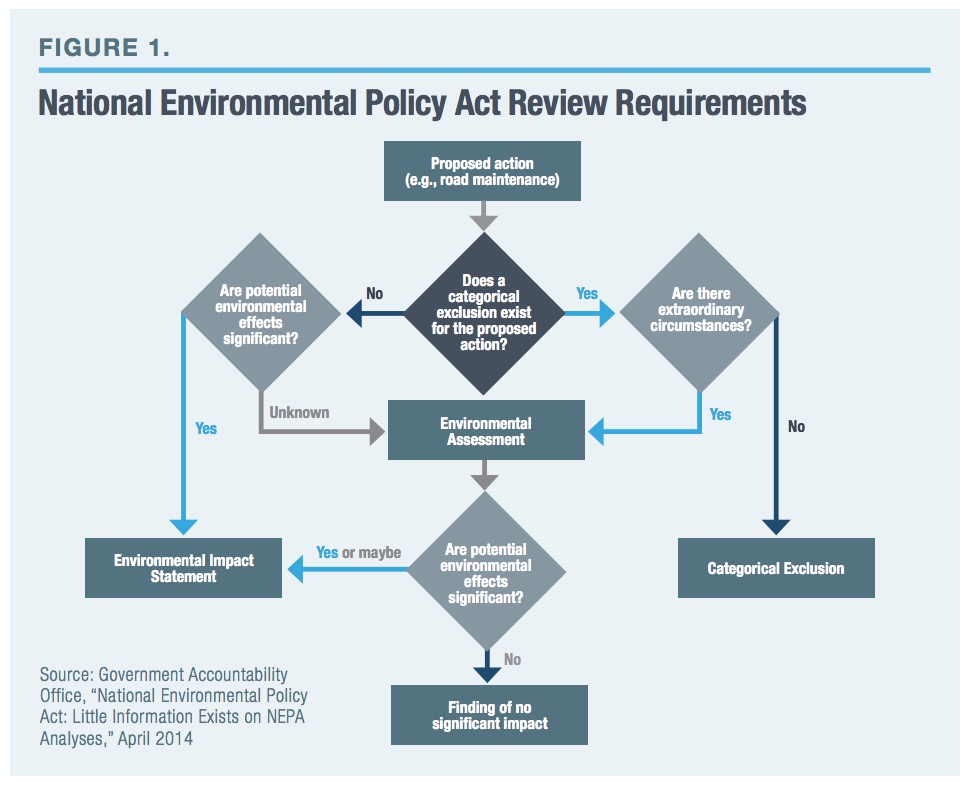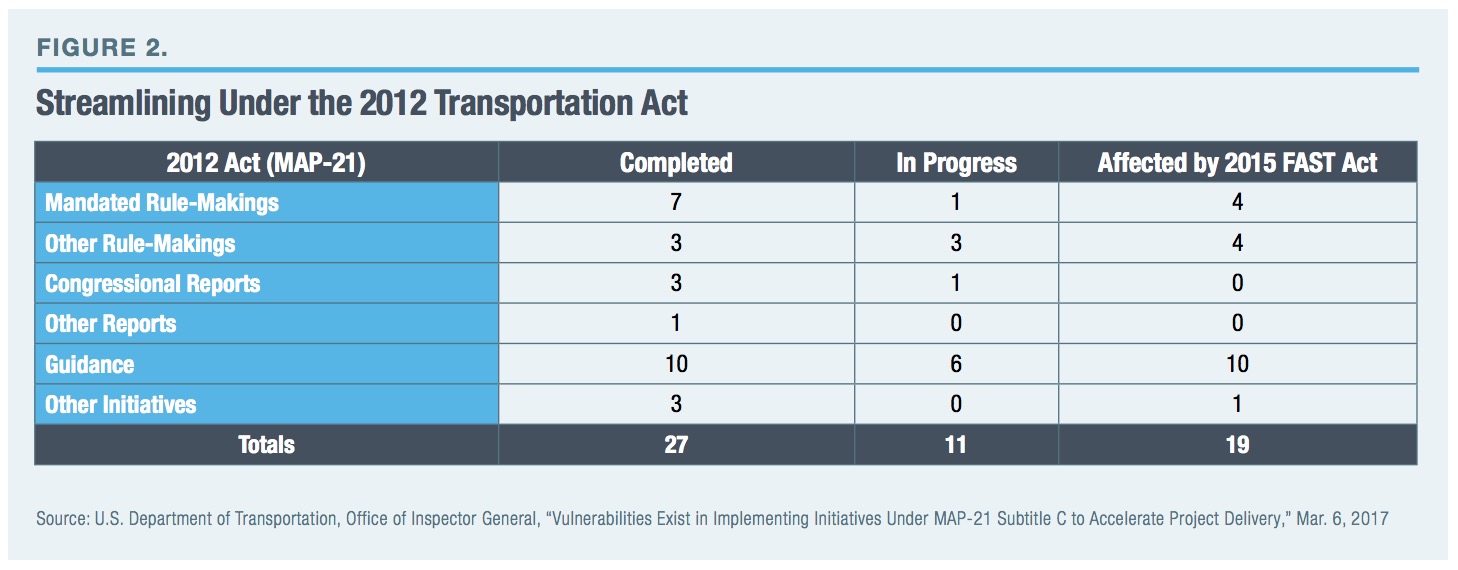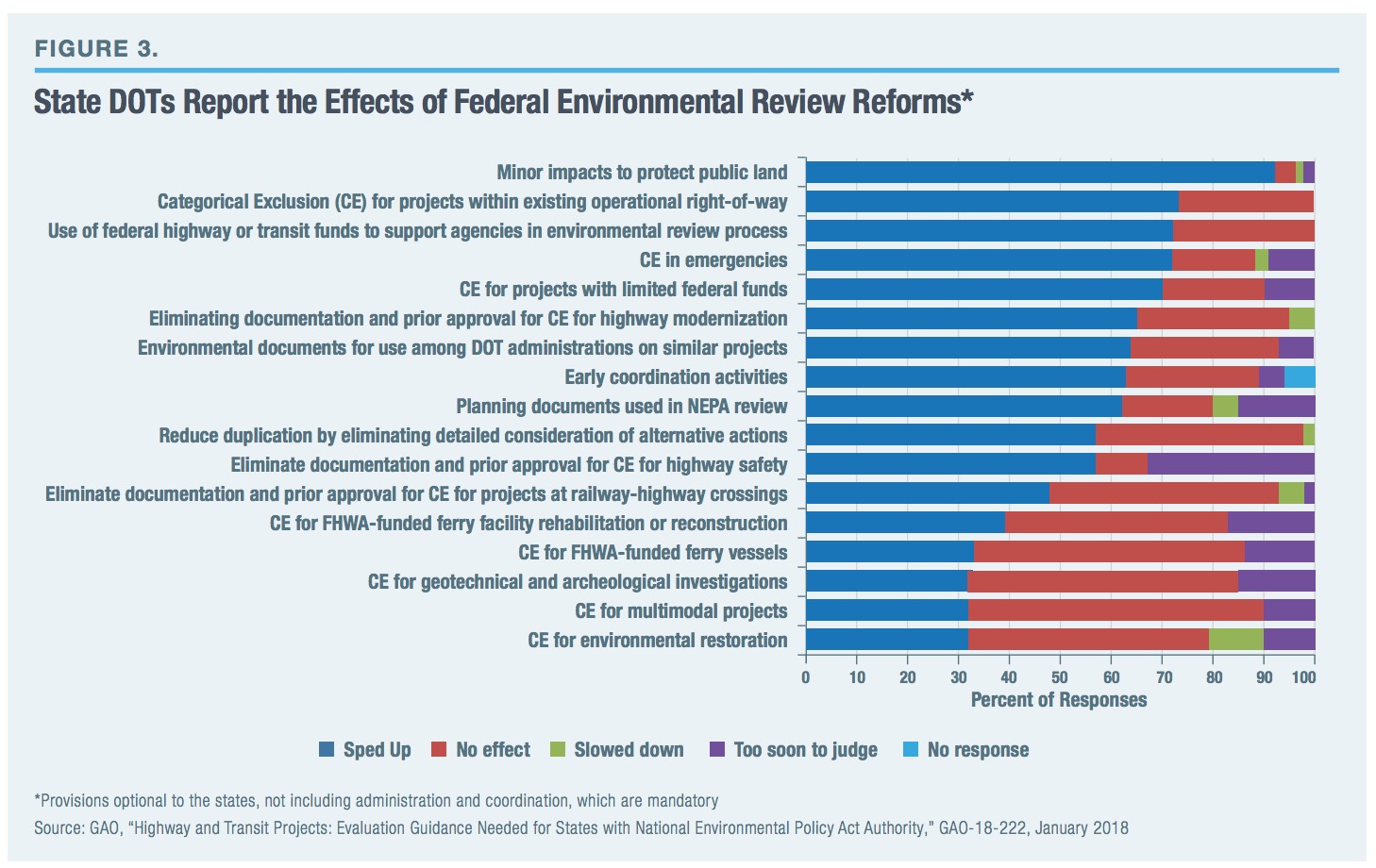MANHATTAN INSTITUTE
Written by Charles Hughes, Policy Analyst
Executive Summary
 Many roads, bridges, sewers, pipelines, and other infrastructure need repair. New facilities should also be built where economic and social conditions warrant. Yet even where money is not an obstacle, the reviews that are required by the National Environmental Policy Act (NEPA) can be a significant source of delay. The average time to complete a final Environmental Impact Statement (EIS), for example, was 5.1 years in 2016. Only 16% of them were completed in two years or less.
Many roads, bridges, sewers, pipelines, and other infrastructure need repair. New facilities should also be built where economic and social conditions warrant. Yet even where money is not an obstacle, the reviews that are required by the National Environmental Policy Act (NEPA) can be a significant source of delay. The average time to complete a final Environmental Impact Statement (EIS), for example, was 5.1 years in 2016. Only 16% of them were completed in two years or less.
Lengthy reviews introduce uncertainty, add to the costs, and threaten the viability of infrastructure projects. Meanwhile, existing facilities continue to deteriorate as proposed upgrades or replacements wind their way through federal and state regulatory bodies. The problem is long-standing, and Congress has taken a number of steps over the last several years to streamline the process.
This paper assesses their effectiveness and proposes some additional changes, including:
- Updating rules and procedures at the agency level to exempt additional infrastructure projects from lengthy and complex review requirements.
- Expanding eligibility and giving agencies more flexibility to make use of NEPA’s “categorical exclusion” provisions.
- Assigning more environmental review duties to states. For more than a decade, a program called NEPA Assignment has allowed states to take the lead on shepherding certain highway and transit projects through environmental review. The states that have done so report reduced time required to complete environmental reviews. More states should be encouraged to participate. The federal government should expand the number of projects and actions that are eligible under existing authority, and Congress should expand the program to cover more kinds of infrastructure.
With the implementation of these recommendations, federal agency resources would be freed to deal with the complex projects that require more comprehensive review, reducing the time for projects that pass muster to begin.
Introduction
The 1970 National Environmental Policy Act (NEPA) requires federal agencies to review the potential environmental, social, and economic effects of proposed infrastructure projects that require some form of federal action—whether funding or granting permits—or that deal with federal facilities or land.
There are three levels of analysis under the NEPA framework. The largest, complex projects require the most comprehensive analysis, resulting in a final Environmental Impact Statement (EIS). During 2008–12, agencies issued 1,125 of these statements. Fewer than 1% of the projects subject to NEPA require an EIS. About 4% require a less comprehensive Environmental Assessment (EA). About 95% of NEPA analyses are categorical exclusions, which are faster and more streamlined.
Categorical exclusion determinations generally take only a few days, while the time to complete Environmental Assessments ranges from four to 18 months. The average preparation time for an EIS was 5.1 years in 2016, up from about three years in 2000.
According to a Congressional Research Service (CRS) report, NEPA’s framework “can lead to confusion” (Figure 1). It can also be the source of disputes or disagreements among different agencies and give outside groups in disagreement with NEPA procedures an opportunity to sue.
With long review times, the viability of some projects is called into question, the health of existing assets can deteriorate further, and the deployment of new technologies can be delayed because the necessary infrastructure is not in place.
The federal government’s Permitting Dashboard shows the number and scale of many of the projects currently going through the NEPA process. As of May 2018, the U.S. Department of Transportation (DOT) was the lead agency for 141 projects, while state DOTs were the lead in another 70.
Of the final Environmental Impact Statements that were completed in 2015, only 16% were completed within two years. About 29% took longer than six years.
The Progress of Reform
Beginning with a 2005 transportation act, Congress has sought to streamline and speed up environmental reviews. The two most recent laws are the Moving Ahead for Progress in the 21st Century Act (MAP-21), in 2012; and the Fixing America’s Surface Transportation Act (FAST), in 2015. The provisions in these laws include assigning more responsibilities to the states and expanding categorical exclusion determinations to allow for more projects to qualify. In addition, individual agencies have updated their rules to exempt certain actions from review requirements.
There have been some problems. As of March 2017, only 27 of 42 planned actions for implementing MAP-21 legislation had been completed. FAST, intended to speed up projects, has, in some instances, led to delay, as many of the procedures called for in MAP-21 had to be revised in order to comply with the new law’s requirements. In total, 19 of the 42 rule-makings, guidance, and reports called for were altered, including 10 of the 27 actions already completed (Figure 2).
In addition to the legislative reforms, President Trump signed Executive Order 13807 on August 15, 2017. This order established the One Federal Decision framework, under which a single designated agency will shepherd each infrastructure project through the review and authorization process. Instead of cooperating agencies conducting their own analyses and records of decision, the lead agency would coordinate with others on a single record of decision and serve as the point of contact for project sponsors when questions or problems arise. The order gave the White House Council on Environmental Quality (CEQ oversees the implementation of NEPA) dispute resolution authority in areas not already covered by previous legislation or executive orders. Importantly, Executive Order 13807 directs federal entities to establish a goal to reduce the time of review and authorization decisions for major infrastructure projects requiring an EIS to two years.
How effective have these various reforms been? A January 2018 Government Accountability Office (GAO) report13 surveyed state DOTs regarding their use of a variety of some 31 provisions in federal legislation from 2005 to 2015 meant to speed up environmental evaluations of highway and transit projects. These included provisions that allow eligible projects to bypass some aspects of NEPA review, such as through the expansion of categorical exclusion determinations (Accelerated Review); provisions under which states can assume NEPA authority and undertake duties of environmental review and approval (NEPA Assignment); and provisions directed toward making the review processes themselves more effective, by establishing time frames or minimizing duplication (Administrative and Coordination Changes).
Of the 31 provisions, 17 are optional for states; and for 11 of them, the majority of participating state DOTs said that the provision had helped to speed up project delivery (that is, completion of government review and awarding a permit to begin work) related to NEPA review, while very few states indicated that the provision slowed the timetable (Figure 3).
So far, six states have assumed authority for completing environmental reviews of highway and transit projects under the NEPA Assignment provisions, starting with California in 2007, followed by Texas in 2014, Ohio in 2015, Florida in 2016, and Utah and Alaska in 2017. In its most recent report, the California Department of Transportation showed that it has been able to significantly reduce review times. Before NEPA Assignment, approval of final EISs took a median of 9.9 months; that period has declined to 5.5 months. California also reports that the median time for draft EAs went from 5.4 months to 2.4 months (Figure 4). The time savings have been more substantial for document preparation. In the pre-NEPA Assignment baseline, the median time from filing a Notice of Intent to prepare an EIS to the approval of a final EIS was 194 months; this has declined to 69 months. Median times for preparation of other types of analysis also saw significant reductions of at least 10.7 months.
Texas has not yet started an EIS through NEPA Assignment, but its average EA completion times have declined from 2.5 years to 1.5 years. Other participating states in the assignment program do not yet have enough data to provide estimates of times saved.
While provisions related to NEPA Assignment and Accelerated Review have demonstrated success in reducing review time, so far the majority of Administration and Coordination provisions have had either no effect on review and permitting times or the data are insufficient to make a judgment. Further improvements to Administration and Coordination in Executive Order 13807—most notably, the One Federal Decision framework—were put into effect only in April 2018.
Download full version (PDF): Streamlining Infrastructure Environmental Review
About the Manhattan Institute
www.manhattan-institute.org
The mission of the Manhattan Institute is to develop and disseminate new ideas that foster greater economic choice and individual responsibility. The Institute serves as a leading voice of free-market ideas, shaping political culture since our founding in 1977. Ideas that have changed the United States and its urban areas for the better—welfare reform, tort reform, proactive policing, and supply-side tax policies, among others—are the heart of MI’s legacy. While continuing with what is tried and true, we are constantly developing new ways of advancing our message in the battle of ideas.
Tags: Charles Hughs, Manhattan Institute, National Environmental Policy Act, NEPA








 RSS Feed
RSS Feed